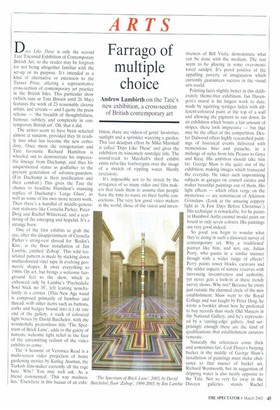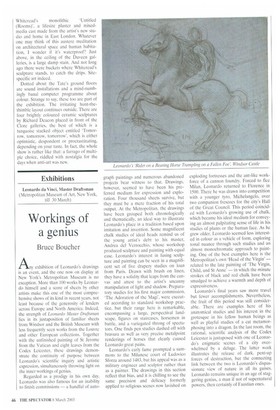Farrago of multiple choice
Andrew Lambirth on the Tate's new exhibition, a cross-section of British contemporary art
Days Like These is only the second Tate Triennial Exhibition of Contemporary British Art, so the reader may be forgiven for not being altogether familiar with the set-up or its purpose. It's intended as a kind of alternative or extension to the Turner Prize, offering a representative cross-section of contemporary art practice in the British Isles. This particular show (which runs at Tate Britain until 26 May) features the work of 23 reasonably diverse artists, and reveals — and I quote the press release — 'the breadth of thoughtfulness, humour, subtlety and complexity in contemporary British art'. Oh, that it did.
The artists seem to have been selected almost at random, provided they fit readily into what has become the new orthodoxy. Once more the octogenarian and Tate favourite Richard Hamilton is wheeled out to demonstrate his impeccable lineage from Duchamp, and thus his unquestioned status as godfather to the present generation of advance-guarders. (For Duchamp is their justification and their comfort.) This gives the Tate the chance to headline Hamilton's stunning replica of Duchamp's 'Large Glass', as well as some of his own more recent work. Then there's a handful of middle-generation stalwarts like Cornelia Parker, Peter Doig and Rachel Whiteread. and a scattering of the emerging and hopeful. It's a strange brew.
One of the first exhibits to grab the eye, after the disappointment of Cornelia Parker's string-vest shroud for `Rodin's Kiss'. is the floor installation of Jim Lambie, entitled 'Zobop'. This wild tes selated pattern is made by sticking down
multicoloured vinyl tape in evolving geometric shapes. It owes everything to
1960s Op art, but brings a welcome fair ground feel to the show, which is enhanced only by Lambie's 'Psychedelic Soul Stick no 38', left leaning noncha lantly in a corner. (This New Age wand is composed primarily of bamboo and thread, with other items such as buttons,
corks and badges bound into it.) At one end of the gallery., a stack of coloured
light boxes by David Batchelor, with the wonderfully pretentious title 'The Spectrum of Brick Lane', adds to the gaiety of nations; welcome light relief in the face of the unremitting tedium of the video exhibits to come.
The '4 Seasons' of Veronica Read is a multi-screen video projection of home gardening movies by Kutlug Ataman, the Turkish film-maker currently all the rage here. Why? You may well ask. As a friend commented, 'This way madness lies.' Elsewhere in this bazaar of an exhi bition, there are videos of gents' lavatories, sunlight and a sprinkler watering a garden. This last deadpan effort by Mike Marshall is called 'Days Like These' and gives the exhibition its winsomely nostalgic title. The sound-track to Marshall's third exhibit emits tuba-like borborygms over the image of a stretch of rippling water. Hardly revelatory.
It's impossible not to be struck by the arrogance of so many video and film makers that leads them to assume that people have the time to waste on their feeble concoctions. The very few good video makers in the world, those of the vision and inven tiveness of Bill Viola, demonstrate what can be done with the medium. The rest seem to be playing in some over-monitored sandpit. It's proof positive of the appalling poverty of imagination which currently guarantees success in the visual arts world.
Painting fares slightly better in this deliberately theme-free exhibition. Ian Davenport's mural is his largest work to date, made by squirting syringes laden with different-coloured paint at the top of a wall and allowing the pigment to run down. In an exhibition which boasts a fair amount of stripes, these look impressive but that may be the effect of the competition. Dexter Dalwood offers highly researched paintings of historical events delivered with tremendous brio and panache, in a mélange of styles from late Picasso to Goya and Kitaj. His ambition should take him far. George Shaw is the quiet star of the exhibition, making images which transcend the everyday. He takes such unpromising subjects as garages on council estates and makes beautiful paintings out of them. His light effects — which often verge on the mysterious — are reminiscent of Atkinson Grimshaw. (Look at the amazing coppery light in 'A Few Days Before Christmas') His technique is remarkable, for he paints in Humbrol Airfix enamel model paint on board in only seven colours. His paintings are very good indeed.
So good, you begin to wonder what they're doing in such a distorted survey of contemporary art. Why a 'traditional' painter like him, and not, say. Julian Perry, who paints in a similar manner though with a wider range of effects? Perry paints tower blocks, caravans and the odder aspects of nature reserves with increasing inventiveness and authority, yet never gets a look-in at these trendy survey shows. Why not? Because he exists just outside the charmed circle of the new establishment. Shaw went to the Royal College and was taught by Peter Doig, he wrote a booklet about how he preferred to buy records than study Old Masters in the National Gallery, and he's represented by a 'cutting-edge' gallery. And surprisingly enough these are the kind of qualifications that establishment curators venerate.
Naturally the references come thick and sometimes fast. Ceal Floyer's burping bucket in the middle of George Shaw's installation of paintings must make obeisance to that master of bucket art, Richard Wentworth, but its suggestion of dripping water is also neatly apposite to the Tate. Not so very far away in the Duveen galleries stands Rachel Whiteread's monolithic 'Untitled (Rooms)', a lifesize plaster and mixedmedia cast made from the artist's new studio and home in East London. Whatever one may think of this austere meditation on architectural space and human habitation, I wonder if it's waterproof? Just above, in the ceiling of the Duveen galleries, is a large damp stain. And not long ago there were buckets where Whiteread's sculpture stands, to catch the drips. Sitespecific art indeed.
Dotted about the Tate's ground floors are sound installations and a mind-numbingly banal computer programme about colour. Strange to say, these too are part of the exhibition. The irritating hunt-thethimble layout continues outside. There are four brightly coloured ceramic sculptures by Richard Deacon placed in front of the Clore galleries, the best of which is a turquoise stacked object entitled 'Tomorrow, tomorrow, tomorrow', which is either optimistic, despondent or procrastinating, depending on your taste. In fact, the whole show is rather like that: a farrago of multiple choice, riddled with nostalgia for the days when anti-art was new.



































































 Previous page
Previous page